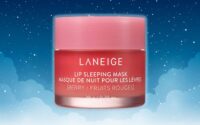Spray-on sneaker created by a robot in 6 minutes will make history at 2024 Olympics
Hellen Obiri, the Kenyan distance runner and two-time Olympic silver medalist, will make history at the 2024 Paris Olympics — thanks to her shoes.
Obiri will be sporting a new sneaker from sportswear company On, but it’s far from a typical sneaker.
On’s Cloudboom Strike LS is spray-on footwear.
“LS” stands for LightSpray, the trademarked name of the technology used to create the shoes. It works by placing a foot form on the arm of a robot as the shoe’s entire upper part is sprayed on from a single continuous filament — in just three minutes, according to Fast Company.
The robot arm holds the outsole up to a sprayer as the arm rotates the shoe and the sprayer releases thermoplastic polyurethane (TPU) — a material with characteristics of both plastic and rubber — spiraling the stream as a helix. It lands as a single continuous string and bonds to the outsole and itself without any glue.
Next, the robot arm will pass the shoe along to another robot that sprays it with color. That cures in just three minutes, and then the shoes are immediately ready for wearing.
This technology is revolutionary because the shoe’s upper is the hardest part to produce. While the fluffy outsoles are made in a mold, the upper deals with all the intricacies of traditional garment production such as stitching, glue, fabrics and tension wires.
“Modern shoemaking is not so modern,” Ilmarin Heitz, senior director of footwear at On, told the outlet. “It’s just using 2D patterns … and we’re trying to wrap them around a very complex 3D shape.”
He added that the material used in LightSpray technology is so form-fitting that athletes often opt to wear it without socks.
Now, the shoes are going to get their world debut at the Olympics in Paris — though Obiri was initially hesitant.
“The first time I saw the shoes, I said, ‘No,’” Obiri told the New York Times. “‘I can’t run with these.’
“In the changing room, even my colleagues were saying, ‘It’s a joke,’” she added. “They were saying, “‘You can’t use these shoes for a marathon.’”
She decided to try wearing them in practice and eventually the Boston Marathon in April — which she won.
“She wouldn’t give them back,” Nils Altrogge, the director of innovation, technology and research for On, quipped.
“When you trust the shoes, you have that mentality, like, ‘I’m going to run fast,’” Obiri shared.
On claims that the technology doesn’t just decrease production time — it also reduces 75% of the carbon footprint of the upper production.
“One of the visions was, imagine if you go to a race, you have one of these robots with you, and on race day, if it’s wet or dry, the robot sprays you a perfect shoe for the moment,” Heitz explained. “And at the end of the race you take it off, recycle it, and go to the next race.”
Oddly enough, the idea for this kind of production came four years ago on Halloween from a senior member of On’s innovation team, Johannes Voelchert.
Voelchert saw a video of someone who squeezed a thin filament of hot glue into a fluff of spider web and wondered if a shoe could be made the same way.
Heitz was all for it.
“My brief was, ‘You go wild, go crazy, and I pay.”
The Cloudboom Strike LS was the debut of LightSpray technology. It was first offered for a limited time in April, but it will be available again this fall for $330 — just in time for the New York City Marathon on Sunday, Nov. 3.


